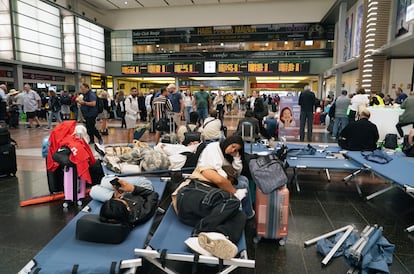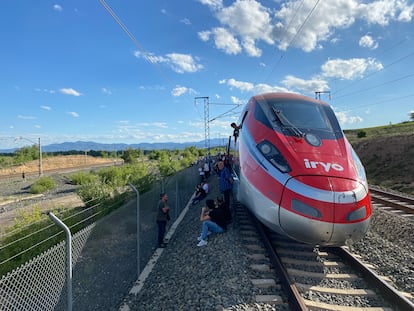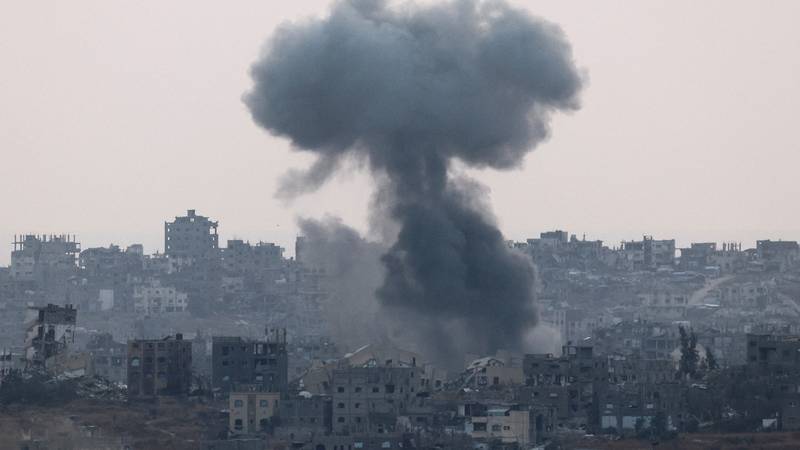Varying trains during the blackout, the vulnerability of cleaner transport | Economy

The effort of billions of public investment in the electrification of almost 70% of the 15,600 kilometers of route managed by Adifs outlined last Monday, The general blackoutone of the most remote risk factors for train transport: the cancellation of the service throughout the country and for many hours due to lack of tension. The fall was immediate and on all lines, leaving A hundred long -distance convoys stranded on full trip and more than 35,000 people incommunicado on board. Many more trains were paralyzed in the stations until the next day, with the consequent agglomerations and the image of travelers damn in banks or scattered on the ground next to their suitcases. It is a contingency, that of the electric zero, assumed in favor of the decarbonization of transport.
« Monday’s blackout, as in many other areas or sectors, underlines the importance of deepening even more in contingency plans that can respond to such exceptional situations. And this drives us to continue working in a collaborative way to guarantee a more resilient rail network against unexpected events, » explains Pedro Fortea, general director of the Association of the Spanish Railway Industry (Mafex), who defends the key role of the key transportation Despite this and other incidents: « We must not lose sight of the strategic function of the railroad in the present and future of the country, as well as the great value it contributes to citizens, something that has become even more evident when its use has been impossible. »
The electrification of the first line in Spain, 21 kilometers in Almeria, is not now. It came into operation in 1912, but progress has barely been in infrastructure protection systems and it has been done in traction transformers. This collapse of the service, which already goes to the history of transport, adds to other recent incidents, such as the fall of the high speed trains Avril de Renfe on January 1 For a software error; the chain of failures in the same model during the summer; The derailment in October of a train traveling towed In the Madrid-Atocha Madrid tunnel; or the breakdowns of many mornings in the vicinity and rodalies networks.
If the railroad is one of the main electricity consumers in the country, the challenge is to guarantee the reliability of the system at doors to multiply energy demand, for example, by data centers. Other obligations are that of cybersecurity, the renewal of fleets already underway or the predictive maintenance of both trains and infrastructure, In order to underpin a reliable service for users Or, as the Minister of Transportation, Oscar Puente, usually proclaimed that « the railroad lives the best moment in its history. »
ADIF is at records of record investment to finish the high speed network, with corridors to the Basque Country, Extremadura or the Mediterranean, and to modernize the conventional road framework. All electrified. A former technical manager of the Infrastructure Administrator, who asks for anonymity, smiles at the question about possible alternatives to avoid chaos like Monday: “A linear infrastructure such as the railway cannot count on food plants or sufficient emergency generators, such as those that can nurture an airport or a shopping center. And neither should they be dreamed of solar panels next to the roads.”
The network is supplied by hundreds of electrical substations and the energy demand of each machine in circulation is high enough to hinder alternative feeding modes. “In high speed, diesel traction is barely used beyond trains that can embark auxiliary generators for last mile maneuvers or reach certain destinations, and in speeds of less than 250 kilometers per hour increasing towed, ”argues the veteran rail.
The eventuality of the absolute energy zero, as reported in his account in social network X the president of Renfe, Álvaro Fernández Herediait should not be one of those trained in drills: “They have been very intense hours before a challenge that the rail system has rarely seen, such as the total collapse of the entire network. Behind this there are many things that are not seen: dead trains distributed throughout the geography, travelers to sometimes attend without communications, many things to organize and raise a infrastructure palm to Palmo,”

The first Renfe executive assured that the time to revive the service was optimal, although it was not achieved throughout Monday. From Renfe herself it was then highlighted that reopening the circulations would still cost a minimum of two hours since the restoration of tension in the lines. The argument of the record in the recovery of the system has also been used by the president of Redeia, Beatriz Corredor, in this case talking about the electricity grid, as a milestone compared to emergencies in the United States, France, Germany or Italy. « The replacement of the system was exemplary, it was a feat and it was super fast, » said Corredor In an interview with El País.
Climate action
In spite Renewables gain weight in energy mix. And the most notable is the reduction of environmental impact, including acoustic, in addition to the greatest efficiency in consumption against diesel trains.
Renfe estimates that he has reduced his carbon footprint per unit transported by 88% since 1990, the base of the Kyoto protocol. Its trains with electric traction, according to the operator’s calculations, save 4.1 million tons per year of CO2 to the atmosphere and the consumption of 1.1 million tons of fuel, which is equivalent to the domestic consumption of 15 million inhabitants. This public company, together with Adif and Adif High Speed, has in execution a director plan to fight climate change based on energy management, energy efficiency and decarbonization. The commitment is to reduce 9.9 million tons of CO2 by 2030 and saving more than 250 million euros in external costs. Electrification is at the center of all this.
Other uses, although in the process of development, are the regenerative braking systems, with the conversion of the kinetic energy of the train into electricity during the braking process; and the best adaptation of intelligent management systems. In addition, progress is sought towards storage, which perhaps ends up serving as support for serious voltage falls.
Beyond the thousands of kilometers of track, which must be reinforced, different experts consulted explain, is the safety of the energy supply in the traffic control centers. It is about avoiding the disconnection of the systems that coordinate signaling and communications, which ends up translating in minutes or even hours of interruption of services. In this type of facilities, such as airports, structure support and uninterrupted feeding systems come into play.
A report by the consultant Lasker entitled Future challenges, strengths and needs of the Spanish railway sector It has become a guide for an entire industry that seeks the greatest possible resilience for the train. Promoted by Mafex and presented on April 10 by Minister Puente, highlights the need to continue expanding the electrified network and bet on hydrogen and batteries as alternative sources.

The latter, the study points out, « are useful to solve some limitations of the use of electrification, such as last mile, tunnels and natural parks, since they reduce the need for rail operators to install or improve aerial cables in un -electrified roads. » As for hydrogen, experts who have collaborated in this work, including two former presidents of Renfe, Juan Alfaro and Julio Gómez Pomar, speak of an « early phase of their development » and a « potential for regional transport of travelers, in areas of low population density and on routes where electrifying is not economically profitable. » For load traffic, and due to the limited power of hydrogen, « priority remains electrification. »
In full implementation of artificial intelligence, Big Data, Cloud Computing and other digital advances, with special attention to cybersecurity, the importance of a R&D more attached to the infrastructure has become evident. It seeks to improve the contact models between the wheel and the lane; the effect of friction conditions; Durable, efficient, sustainable and recyclable construction materials; Advances in track width change technology, and the stability of power supply.
Cleaner mobility
The transport sector is responsible for about 26% of greenhouse gas emissions, with a 0.3% contribution by the railroad. Renfe estimates that replacing the movements of people and merchandise in their trains would require 382 million circulations by car; 4.4 million routes by heavy vehicles, and about 117,000 flights.
Railroad electrification, clearly sponsored by community regulations, occurs in a context in which mobility takes 40% of the final energy consumed in Spain, as shown by the transport and logistics observatory with data prior to the pandemic, a quota 10 points greater than the European average.







